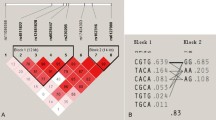Abstract:
Osteoporosis is a common disease with a strong genetic component, characterized by reduced bone mineral density and increased fracture risk. Although the genetic basis of osteoporosis is incompletely understood, previous studies have identified a polymorphism affecting an Sp1 binding site in the COLIA1 gene that predicts bone mineral density and osteoporotic fractures in several populations. Here we investigated the role of COLIA1 genotyping and bone densitometry in the prediction of osteoporotic fractures in a prospective, population-based study of men (n= 156) and women (n= 185) who were followed up for a mean (± SEM) of 4.88 ± 0.03 years. There was no significant difference in bone density, rate of bone loss, body weight, height, or years since menopause between the genotype groups but women with the “ss” genotype were significantly older than the other genotype groups (p= 0.03). Thirty-nine individuals sustained 54 fractures during follow-up and these predominantly occurred in women (45 fractures in 30 individuals). Fractures were significantly more common in females who carried the COLIA1“s” allele (p= 0.001), although there was no significant association between COLIA1 genotype and the occurrence of fractures in men. Logistic regression analysis showed that carriage of the COLIA1“s” allele was an independent predictor of fracture in women with an odds ratio (OR) [95% CI] of 2.59 [1.23–5.45], along with spine bone mineral density (OR = 1.57 [1.04–2.37] per Z-score unit) and body weight (OR = 1.05 [1.01–1.10] per kilogram). Moreover, bone densitometry and COLIA1 genotyping interacted significantly to enhance fracture prediction in women (p= 0.01), such that the incidence of fractures was 45 times higher in those with low BMD who carried the “s” allele (24.3 fractures/100 patient-years) compared with those with high BMD who were “SS” homozygotes (0.54 fracture/100 patient-years). We conclude that in our population, COLIA1 genotyping predicts fractures independently of bone mass and interacts with bone densitometry to help identify women who are at high and low risk of sustaining osteoporotic fractures.
Similar content being viewed by others
Author information
Authors and Affiliations
Additional information
Received: 16 November 2000 / Accepted: 9 June 2000
Rights and permissions
About this article
Cite this article
McGuigan, F., Armbrecht, G., Smith, R. et al. Prediction of Osteoporotic Fractures by Bone Densitometry and COLIA1 Genotyping: A Prospective, Population-Based Study in Men and Women . Osteoporos Int 12, 91–96 (2001). https://doi.org/10.1007/s001980170139
Issue Date:
DOI: https://doi.org/10.1007/s001980170139



